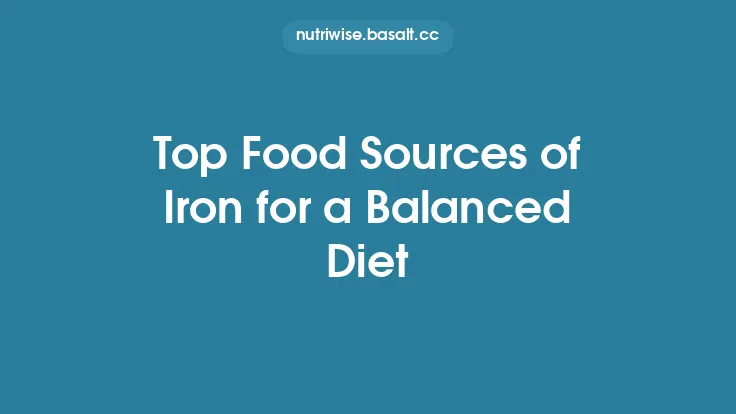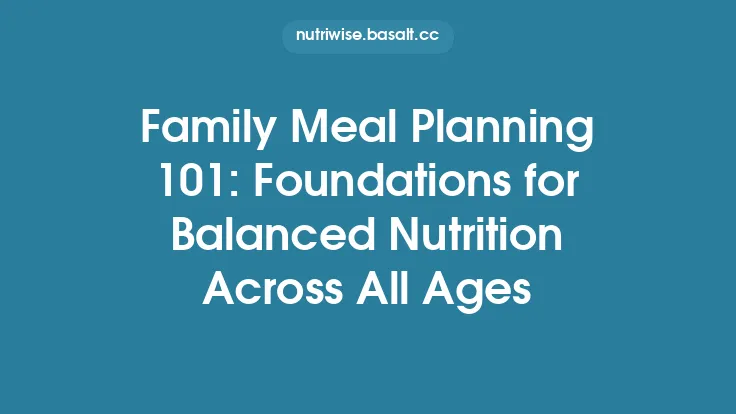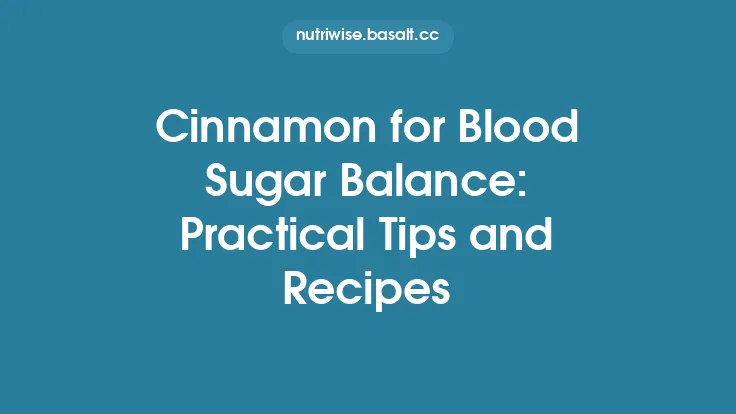Micronutrients—vitamins, minerals, and phytonutrients—are the silent architects of health. While macronutrients supply the energy and building blocks our bodies need, it is the micronutrients that fine‑tune metabolic pathways, support immune function, protect cellular structures, and enable the countless enzymatic reactions that keep us alive. Yet, the modern diet often falls short of delivering a balanced micronutrient profile, not because of a lack of food, but because of the way we select, prepare, and combine ingredients.
This handbook is designed to bridge that gap. It offers a practical, recipe‑focused approach that equips anyone—from a busy professional to a home‑cooking enthusiast—with the knowledge and tools to create meals that are not only delicious but also densely packed with the vitamins, minerals, and bioactive compounds our bodies crave. By the end of this guide, you will be able to:
- Identify the micronutrient “signatures” of common ingredients.
- Apply cooking methods that maximize nutrient retention.
- Construct balanced plates where micronutrients complement each other.
- Adapt recipes to meet the unique needs of different life stages and activity levels.
Below, each section builds on the previous one, moving from foundational concepts to concrete, ready‑to‑cook recipes, and finally to strategies for preserving those nutrients from pot to plate.
Understanding Micronutrient Needs in Everyday Diets
1. The Micronutrient Landscape
| Micronutrient | Primary Physiological Role | Typical Daily Requirement* |
|---|---|---|
| Vitamin A (Retinol/β‑carotene) | Vision, immune modulation, skin health | 700–900 µg RAE |
| Vitamin C (Ascorbic acid) | Antioxidant, collagen synthesis, iron absorption | 75–90 mg |
| Vitamin D (Calciferol) | Calcium homeostasis, bone health, immune regulation | 600–800 IU |
| Vitamin E (α‑tocopherol) | Membrane protection, antioxidant | 15 mg |
| Vitamin K (K1, K2) | Blood clotting, bone metabolism | 90–120 µg |
| B‑Complex (B1‑B12) | Energy metabolism, nerve function, red blood cell formation | Varies (e.g., B12 ≈ 2.4 µg) |
| Iron | Oxygen transport, enzymatic reactions | 8–18 mg |
| Calcium | Bone/teeth formation, muscle contraction | 1,000–1,200 mg |
| Magnesium | ATP production, neuromuscular function | 310–420 mg |
| Zinc | Immune function, DNA synthesis | 8–11 mg |
| Selenium | Antioxidant enzymes, thyroid hormone metabolism | 55 µg |
| Potassium | Fluid balance, nerve transmission | 2,600–3,400 mg |
\*Values are based on average adult recommendations (RDA/AI). Individual needs may vary.
2. Why Micronutrient Gaps Occur
- Processing loss – Refinement, canning, and high‑heat cooking can degrade heat‑sensitive vitamins (e.g., vitamin C, folate).
- Bioavailability constraints – Certain minerals (iron, calcium) are less absorbable when bound to phytates or oxalates.
- Monotonous dietary patterns – Repeated reliance on a narrow set of staple foods limits the spectrum of phytonutrients.
Understanding these mechanisms informs the recipe strategies that follow.
Core Principles for Designing Micronutrient‑Rich Recipes
- Diversity of Color and Texture – Each hue signals a distinct class of phytonutrients (e.g., carotenoids in orange carrots, anthocyanins in deep‑purple berries). Aim for at least three colors per plate.
- Complementary Pairings – Pair foods that enhance each other’s absorption (e.g., vitamin C‑rich peppers with iron‑rich legumes).
- Minimalist Heat Exposure – Use quick‑sauté, steaming, or raw preparations for the most heat‑labile nutrients.
- Inclusion of Whole Food Matrices – Whole grains, nuts, and seeds provide minerals in a matrix that supports gradual release and absorption.
- Strategic Use of Fats – Fat‑soluble vitamins (A, D, E, K) require dietary lipids for optimal uptake; a modest amount of healthy oil (olive, avocado) is essential.
- Balancing Acid‑Base – Slightly acidic environments (a splash of lemon juice or vinegar) can improve mineral solubility, especially for iron and calcium.
These principles act as a checklist when you evaluate or create a recipe.
Cooking Techniques that Preserve Vitamins and Minerals
| Technique | Micronutrient Impact | Best‑Practice Tips |
|---|---|---|
| Steaming | Retains >90 % of water‑soluble vitamins (C, B‑complex) compared with boiling. | Use a tight‑fitting lid; steam for the shortest time needed for tenderness. |
| Sautéing (quick, high‑heat) | Preserves heat‑stable vitamins (A, K) while allowing fat‑soluble absorption. | Pre‑heat pan, add oil, and toss vegetables for 2–4 min; avoid overcrowding. |
| Blanching | Locks in color and reduces enzymatic loss of nutrients; useful for freezing. | Boil briefly (30–60 s), then shock in ice water. |
| Roasting | Concentrates flavors; can increase bioavailability of carotenoids via cell‑wall breakdown. | Roast at 180–200 °C for 15–30 min; coat with a thin layer of oil. |
| Fermentation | Boosts B‑vitamins, creates probiotic metabolites, reduces antinutrients. | Allow 24–72 h fermentation for vegetables (e.g., kimchi, sauerkraut). |
| Raw Preparation | Maximizes heat‑sensitive nutrients (vitamin C, folate). | Slice or grate just before serving; dress with acid to prevent oxidation. |
| Microwaving | Short exposure time can preserve nutrients better than conventional cooking. | Use minimal water; cover to create steam. |
Technical note: The rate of vitamin degradation follows first‑order kinetics, meaning that each additional minute of heat exposure exponentially reduces the remaining vitamin content. For example, vitamin C loses roughly 10 % per minute at 100 °C in water. This underscores the value of rapid cooking methods.
Balancing Micronutrients Across Food Groups in a Single Dish
A well‑balanced plate integrates:
- Protein source – legumes, fish, poultry, tofu – providing B‑vitamins, iron, zinc, and selenium.
- Complex carbohydrate – whole grains, starchy vegetables – delivering magnesium, potassium, and B‑vitamins.
- Vegetable medley – a spectrum of colors for vitamins A, C, K, and phytonutrients.
- Healthy fat – nuts, seeds, avocado, or oil – essential for fat‑soluble vitamins and mineral absorption.
Example composition (per 500 kcal serving):
| Component | Quantity | Key Micronutrients |
|---|---|---|
| Grilled salmon | 120 g | Vitamin D, selenium, omega‑3 fatty acids |
| Quinoa (cooked) | ¾ cup | Magnesium, phosphorus, B‑vitamins |
| Roasted Brussels sprouts | 1 cup | Vitamin C, K, folate |
| Sweet‑potato cubes (roasted) | ½ cup | Vitamin A (β‑carotene), potassium |
| Walnut pieces | 2 Tbsp | Vitamin E, magnesium, omega‑3 |
| Lemon‑olive oil dressing | 1 Tbsp | Vitamin E, enhances vitamin A absorption |
By deliberately selecting ingredients that complement each other, the dish delivers a broad micronutrient spectrum without excessive reliance on supplements.
Recipe Frameworks: Building Blocks for Nutrient Density
1. The “Layered Bowl” Blueprint
- Base – Whole grain or legume (e.g., farro, lentils).
- Protein – Animal (fish, poultry) or plant (tofu, tempeh).
- Vegetable Stack – Two or three colors, prepared using varied techniques (raw, roasted, sautéed).
- Healthy Fat – Seeds, nuts, or a drizzle of oil.
- Acidic Finish – Citrus, vinegar, or fermented condiment.
*Why it works:* Each layer introduces a distinct micronutrient group, while the acid and fat components optimize absorption.
2. The “One‑Pot Nutrient Stew”
- Combine a protein source, a starchy vegetable, and a mix of leafy greens in a broth enriched with bone‑derived minerals (calcium, magnesium).
- Simmer briefly to preserve water‑soluble vitamins, then finish with a splash of cold‑pressed oil.
*Why it works:* Minimal handling reduces nutrient loss, and the broth acts as a carrier for leached minerals.
3. The “Quick‑Sear & Raw Pair”
- Sear a lean protein quickly (2–3 min) to lock in B‑vitamins, then top with a raw salad of shredded carrots, kale, and citrus segments.
*Why it works:* Heat‑stable nutrients are preserved in the protein, while heat‑sensitive vitamins remain intact in the raw components.
These frameworks can be customized endlessly, providing a scaffold for creative, nutrient‑dense cooking.
Sample Recipes for Breakfast, Lunch, Dinner, and Snacks
1. Sunrise Power Oatmeal (Breakfast)
Servings: 1
Micronutrient Highlights: Vitamin A (β‑carotene), iron, calcium, vitamin C, magnesium.
| Ingredient | Amount | Micronutrient Contribution |
|---|---|---|
| Rolled oats | ½ cup (dry) | Iron, magnesium, B‑vitamins |
| Fortified almond milk | ¾ cup | Calcium, vitamin D |
| Grated carrot | ¼ cup | Vitamin A, potassium |
| Chia seeds | 1 Tbsp | Calcium, magnesium, omega‑3 |
| Fresh blueberries | ¼ cup | Vitamin C, anthocyanins |
| Ground flaxseed | 1 tsp | Vitamin E, lignans |
| Lemon zest | ½ tsp | Vitamin C, flavonoids |
| Honey (optional) | 1 tsp | – |
Directions
- In a saucepan, combine oats and almond milk. Bring to a gentle boil, then reduce heat and simmer 4 min, stirring.
- Stir in grated carrot and chia seeds; cook an additional 1 min.
- Remove from heat, fold in blueberries, flaxseed, and lemon zest.
- Serve warm; drizzle honey if desired.
Nutrient‑Preservation Note: Carrots are added near the end of cooking to limit β‑carotene degradation, while the brief heat exposure still softens the fibers for easier digestion.
2. Mediterranean Chickpea & Quinoa Salad (Lunch)
Servings: 2
Micronutrient Highlights: Folate, vitamin K, zinc, selenium, vitamin C, iron.
| Ingredient | Amount | Micronutrient Contribution |
|---|---|---|
| Cooked quinoa | 1 cup | Magnesium, B‑vitamins |
| Canned chickpeas (rinsed) | 1 cup | Folate, iron, zinc |
| Diced red bell pepper | ½ cup | Vitamin C, vitamin A |
| Chopped kale (stems removed) | 1 cup | Vitamin K, vitamin C, calcium |
| Sun‑dried tomatoes, chopped | ¼ cup | Lycopene, iron |
| Kalamata olives, sliced | ¼ cup | Vitamin E, healthy fats |
| Crumbled feta cheese | 2 Tbsp | Calcium, vitamin B12 |
| Extra‑virgin olive oil | 2 Tbsp | Vitamin E, aids fat‑soluble vitamin absorption |
| Fresh lemon juice | 1 Tbsp | Vitamin C, enhances iron uptake |
| Dried oregano | ½ tsp | Antioxidants |
| Salt & pepper | to taste | – |
Directions
- In a large bowl, combine quinoa, chickpeas, red bell pepper, kale, sun‑dried tomatoes, and olives.
- In a small jar, whisk olive oil, lemon juice, oregano, salt, and pepper.
- Pour dressing over the salad; toss gently to coat.
- Sprinkle feta on top and serve at room temperature or chilled.
Technical Insight: The acidic lemon dressing chelates iron from chickpeas, converting it to a more soluble ferrous form, which is then readily absorbed in the presence of vitamin C from the bell pepper.
3. Herb‑Crusted Cod with Roasted Root Vegetables (Dinner)
Servings: 2
Micronutrient Highlights: Vitamin D, iodine, vitamin A, potassium, vitamin K, selenium.
| Ingredient | Amount | Micronutrient Contribution |
|---|---|---|
| Fresh cod fillets | 2 × 150 g | Vitamin D, iodine, selenium |
| Whole‑grain mustard | 1 Tbsp | – |
| Fresh parsley, chopped | 2 Tbsp | Vitamin K, vitamin C |
| Fresh dill, chopped | 1 Tbsp | Vitamin K, antioxidants |
| Lemon zest | 1 tsp | Vitamin C |
| Olive oil | 2 Tbsp (for coating) | Vitamin E |
| Sweet potatoes, cubed | 1 cup | Vitamin A, potassium |
| Carrots, sliced | ½ cup | Vitamin A, beta‑carotene |
| Parsnip, sliced | ½ cup | Vitamin C, potassium |
| Sea salt & black pepper | to taste | – |
| Fresh lemon wedges | for serving | Vitamin C |
Directions
- Preheat oven to 200 °C (390 °F).
- Toss sweet potatoes, carrots, and parsnip with 1 Tbsp olive oil, salt, and pepper; spread on a baking sheet. Roast 20 min.
- Meanwhile, pat cod dry. Mix mustard, parsley, dill, lemon zest, and remaining olive oil; spread evenly over each fillet.
- After the root vegetables have roasted 20 min, push them to the sides of the sheet and place cod fillets in the center. Return to oven and bake 12–15 min, until fish flakes easily.
- Serve cod atop the roasted vegetables, with lemon wedges.
Nutrient‑Retention Tip: Cod is a delicate source of vitamin D; cooking at moderate temperature for a short period minimizes loss of this fat‑soluble vitamin. The accompanying root vegetables are roasted at a temperature that enhances β‑carotene bioavailability while preserving potassium.
4. Nut‑And‑Seed Energy Bites (Snack)
Servings: 12 bites
Micronutrient Highlights: Vitamin E, magnesium, zinc, selenium, B‑vitamins.
| Ingredient | Amount | Micronutrient Contribution |
|---|---|---|
| Rolled oats | 1 cup | Magnesium, B‑vitamins |
| Almond butter | ½ cup | Vitamin E, magnesium |
| Ground flaxseed | ¼ cup | Vitamin E, omega‑3 |
| Chopped walnuts | ¼ cup | Selenium, vitamin E |
| Pumpkin seeds (pepitas) | ¼ cup | Zinc, magnesium |
| Dried apricots, finely chopped | ¼ cup | Vitamin A, potassium |
| Dark chocolate chips (≥70 % cacao) | 2 Tbsp | Iron, magnesium |
| Honey | 2 Tbsp | – |
| Vanilla extract | ½ tsp | – |
| Pinch of sea salt | – | – |
Directions
- In a food processor, pulse oats, flaxseed, walnuts, and pumpkin seeds until coarsely ground.
- Transfer to a bowl; add almond butter, honey, vanilla, and salt. Mix until a sticky dough forms.
- Fold in chopped apricots and chocolate chips.
- Using a tablespoon, roll the mixture into 12 uniform balls; place on parchment paper.
- Refrigerate for at least 30 min before serving. Store in an airtight container for up to 5 days.
Why it works: The combination of nuts and seeds supplies a spectrum of minerals, while the small amount of dark chocolate adds iron and antioxidants without overwhelming the snack with added sugars.
Adapting Recipes for Specific Populations
| Population | Key Micronutrient Priorities | Recipe Adjustments |
|---|---|---|
| Athletes | Iron, B‑vitamins, magnesium, zinc (energy & recovery) | Increase lean protein portions; add beetroot or spinach for iron; incorporate quinoa or amaranth for magnesium. |
| Pregnant individuals | Folate, iron, calcium, DHA (neural development) | Use fortified cereals; add leafy greens; include fish low in mercury (e.g., sardines) for DHA; substitute dairy with calcium‑rich fortified plant milks. |
| Older adults | Vitamin D, B12, calcium, potassium (bone & nerve health) | Emphasize fatty fish, fortified dairy alternatives, and potassium‑rich vegetables; consider smaller, more frequent meals to aid absorption. |
| Vegetarians/Vegans | Vitamin B12, iron, zinc, calcium, omega‑3 (ALA) | Incorporate fortified nutritional yeast, tempeh, lentils, and chia/flax seeds; use seaweed for iodine; pair iron‑rich legumes with vitamin C sources. |
| Individuals with hypertension | Potassium, magnesium, low sodium | Favor fresh herbs over salt; increase potassium‑rich foods (sweet potatoes, bananas); use low‑sodium broth. |
When tailoring a recipe, maintain the core nutrient‑preserving techniques (quick cooking, healthy fats, acid balance) while swapping or augmenting ingredients to meet the specific micronutrient profile.
Utilizing Herbs, Spices, and Fermented Foods for Micronutrient Boost
- Herbs (parsley, cilantro, basil) – Rich in vitamin K, vitamin C, and flavonoids. Add at the end of cooking to preserve volatile compounds.
- Spices (turmeric, cumin, paprika) – Contain minerals (iron, manganese) and potent antioxidants (curcumin). Pair turmeric with a pinch of black pepper to enhance curcumin absorption via piperine.
- Fermented vegetables (kimchi, sauerkraut) – Provide B‑vitamins (especially B12 in certain strains) and probiotic metabolites that can improve mineral absorption by modulating gut pH.
- Miso and tempeh – Fermented soy products delivering calcium, magnesium, and vitamin K2, which aids calcium deposition in bone rather than arteries.
Incorporating a modest amount (1–2 Tbsp) of these elements per serving can raise the micronutrient density without adding significant calories.
Practical Tips for Portion Control and Nutrient Tracking
- Use a digital kitchen scale – Weighing ingredients ensures consistent micronutrient intake, especially for minerals that are concentration‑dependent (e.g., iron).
- Apply the “Hand‑Portion” method – A palm‑sized protein, a fist‑sized carbohydrate, and two cupped‑hand portions of vegetables approximate a balanced micronutrient distribution.
- Leverage free nutrient databases – USDA FoodData Central or national nutrition tables provide precise micronutrient values per 100 g of food; integrate these into a simple spreadsheet to monitor daily totals.
- Batch‑cook with “nutrient blocks” – Prepare a large batch of a micronutrient‑dense component (e.g., roasted mixed vegetables) and portion it into individual containers for quick assembly.
- Mind the “micronutrient ceiling” – While rare, excessive intake of certain minerals (e.g., iron, selenium) can be harmful. Aim for 100 % of the RDA for most nutrients; only exceed under professional guidance.
These habits transform the handbook from a collection of recipes into a sustainable lifestyle system.
Storing and Reheating Cooked Meals without Nutrient Loss
| Food Type | Optimal Storage | Reheating Guidelines |
|---|---|---|
| Cooked leafy greens | Airtight container, refrigerate ≤ 4 °C, consume within 2 days | Reheat gently in a covered pan with a splash of water; avoid boiling. |
| Roasted root vegetables | Cool to room temperature, then freeze in single‑layer trays before transferring to bags | Thaw in refrigerator, then reheat in oven at 180 °C for 10 min to restore texture. |
| Legume‑based stews | Portion into glass jars, freeze; label with date | Defrost overnight, then simmer on low heat; add a drizzle of oil before serving to replenish fat‑soluble vitamins. |
| Grain salads (quinoa, farro) | Store dry in the fridge with a damp paper towel to prevent drying | Warm briefly in microwave (30 s) or serve cold; add fresh herbs post‑reheat to revive vitamin C content. |
| Fish fillets | Keep in a shallow dish, cover with foil, refrigerate ≤ 2 days | Reheat in a steamer for 5 min; avoid microwave as it can cause uneven heating and nutrient degradation. |
Key principle: Minimize exposure to air, light, and high heat during storage and reheating, as these factors accelerate oxidation of vitamins A, C, and E.
Conclusion: Integrating the Handbook into Daily Life
Micronutrient adequacy is not a distant, abstract goal; it is achievable through intentional, everyday cooking choices. By embracing the core principles outlined—colorful diversity, complementary pairings, nutrient‑preserving techniques, and thoughtful portioning—you can transform ordinary meals into powerful vehicles for balanced nutrition.
Remember that the recipes presented are templates, not rigid prescriptions. Feel free to swap ingredients, adjust spices, or modify cooking methods to suit your palate, cultural preferences, and specific health needs. The true power of this handbook lies in its flexibility: it equips you with a scientific framework that can be applied to any cuisine, any season, and any lifestyle.
Start small. Pick one recipe, practice the cooking techniques, and observe how the flavors and textures evolve when you prioritize micronutrient retention. Over time, these practices will become second nature, and your meals will consistently deliver the full spectrum of vitamins, minerals, and phytonutrients that your body relies on for optimal performance and long‑term health.
Enjoy the journey of cooking with purpose, and let every bite be a step toward a more vibrant, micronutrient‑rich life.





